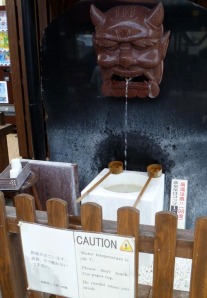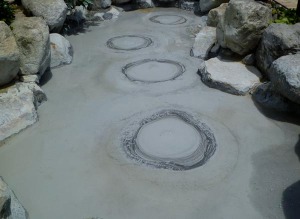Beppu/Kannawa
11/08/2010
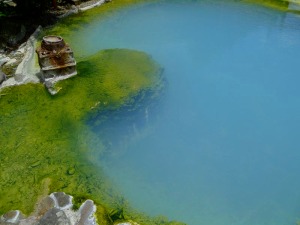
I like the way the cooking station is perched on the little spit of land jutting out into deep boiling water
Coming into Beppu on the train from Kokura station, we were all reminded of Liguria (yeah, the one in Italy)–the landscape and seascape, the ports, the seaside little cities were very similar to Rapallo, Santa Margherita Ligure, Chiavari, and of course Sestri Levante (our town). Maybe it was this sense of familiarity, but I found this part of our trip to be the most comfortable so far (despite the fact that there is practically no English spoken in these parts, even by train station and hotel staff).
At Beppu station, we stashed our luggage in coin lockers and hopped a bus to Kannawa, which is really an inland suburb of Beppu. Kannawa is mostly known for its many “hells” or jigoku. This is an area with intense geothermal activity, and many of the houses here are plumbed to make use of natural steam vents or hot water springs for heating, cooking, and bathing. Those who are not lucky enough to have such resources in-house are able to take their food to public steam kitchens and bathe in public onsen. I could sort of envision a similar burg going up in Wyoming at the site of another famously geothermic hotspot.
The jigoku are the big tourist attractions of Beppu, and you can visit the hells individually for 550 yen per person, or you can buy a book of tickets for eight hell entries for 2000 yen. Those of us old enough to remember Disneyland ticket books may have a moment of geezer-ish nostalgia at this. Six of the hells are located near the Kannawa bus terminal, and the other two are 2.8 km away, which means another bus ride.

Water lilies take advantage of the warmth--not that it was needed. I don't think the temp dropped below 30°C the entire time we were there
There is definitely a carney side-show feel here. The year-round availability of free heat makes it possible to keep tropical plants and exotic animals. For 100 yen you can buy crackers to feed to an ancient-looking African elephant. There’s a hippo that comes and opens its mouth for you so that you can drop in potatoes.
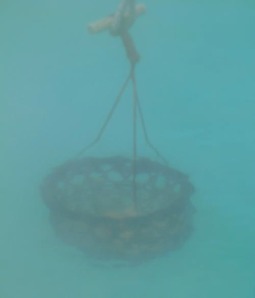
Eggs cooked in the jigoku were a great bargain--100 yen for two eggs, which tasted just like regular hard-boiled eggs.
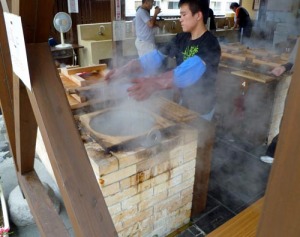
You can bring your food to cook in the steam (conveniently there is a store behind selling lots of different steamable items)
Eggs cooked in the hot water are popular snacks for visitors of the hells, as are buns cooked by the steam, which is venting everywhere. Some of the hells are muddy and gray or red, some clear and azure. Lots of heat, lots of shrines, lots of tourists–though very few westerners, compared with most places that we’d been up to this point. It seems that this area gets a large number of tourists from Korea, as much of the signage is posted bilingually in Japanese and Korean.
A trip to Kannawa would not be complete without a visit to an onsen, though finding one that would accept “tattoo-guys” required the help of the tourist information office. While in the rest of the world everyone an their grandmothers have tats, here in Japan it’s still something that is associated with organized crime. And apparently no one wants to bathe in the same water as someone who snuffs people out or who would cut off his own finger to demonstrate his toughness. Gangsters are considered bad for business for owners of onsen and sentou, and the easiest way to keep them away was to institute a general ban on body art.
Mr. Helpful-Man at the information bureau located the ink-friendly Hyotan spa within walking distance and gave us a coupon for 50 yen off the regular entry price (score!). The routine of shoes off before entering was predictable, except here you carried your shoes inside and stored them in a shoe locker. Then purchase tickets from a machine for spa entry (700 yen), towel (180 for a small, cheap onsen towel you keep or 100 for the rental of a bath towel), and for the yukata (robe) to be worn in the sand bath area, which is the only coed part of the facility (and costing another 200 yen). Tickets and shoe locker key go to attendant (we also got back money for the coupon that we got from Mr. Helpful) and we get back another key for the changing room locker, towels, and yukata.
Over in the men’s changing room one strips starkers, and everything except for the towels gets stored in the locker. Some people bring their own toiletries, but this isn’t necessary because shampoo and body wash are provided at each of the washing stations. Now the Japanese are adamant about having you perfectly squeaky clean before entering the shared water of the bath–obviously the point of the bath is not about getting clean. They are also adept at self-washing while seated on a tiny footstool and using a spigot and a small wooden basin for rinsing. For the rest of us, this onsen has graciously provided a hand-shower.
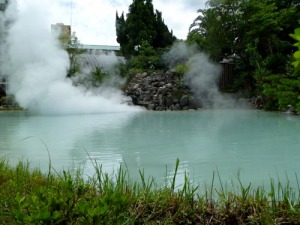
It would be very dangerous to bathe in these waters (and it would be highly inappropriate for me to snap pics while at the onsen...)
In the men’s bathing area there were six baths: a “pebble bath” which was really a walk-through footbath a couple of inches deep, a rock bath, an outdoor garden bath (it looked like a heated koi pond, except for the naked people), a waterfall bath, a bath lined with wooden panels (like a giant sake cup, with naked people), and the onsen’s signature hyotan bath in the shape of a water gourd. This was also the hottest bath, and after just a few minutes I needed to get out and take a rest on this wooden chaise lounge using a four-by-four as a pillow. This was the best part for me.
The sand bath is this gigantic indoor sandbox divided into four sections by concrete footpaths. It’s dry sand, so I suspect it must be using radiant heat from steam-carrying pipes under the sand. The protocol is pretty simple. Rake out a flat depression to lay out in (more four-by-fours provided for headrests), lay self down, cover self with sand. They warn that low-degree burns can occur if you stay for more than twenty minutes.
Afterwards, though, you end up with a lot of sand sticking to your skin, so another trip to the washing station and a Hyotan bath took care of that, but then I needed another rest on the chaise lounge. Bathing is hard work. On the way out I felt rather parched, and–goodness forbid–there he was, the beer guy selling frosty mugs of nama-biiru! Another happy moment involving an amber beverage.




